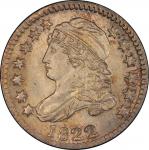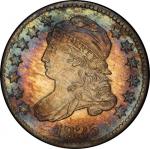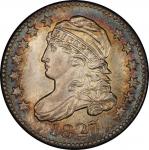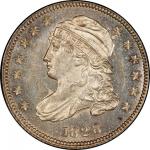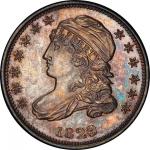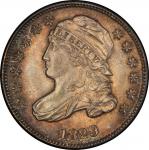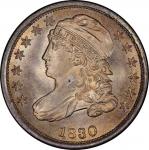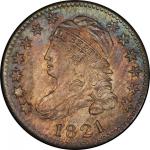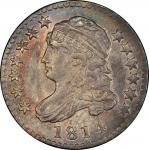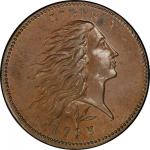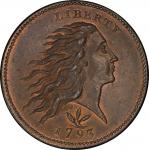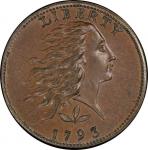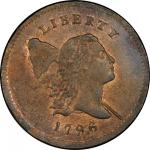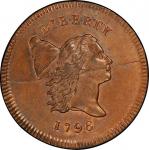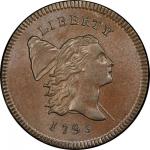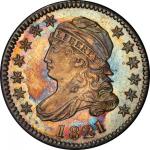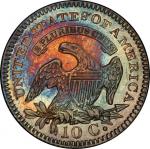“Ten Cent pieces – These were for a time esteemed above their value, but like superficial politicians, they seem to be retiring, as their true worth is understood.” — Western Carolinian, Salisbury, North Carolina, September 11, 1821 Considerable reflectivity remains in the fields of both sides, offering an attractive backdrop for the well-detailed devices. The toning is dramatic and distinctive, showing pale blue tones on the right side of the obverse, while the center and left side is dominated by peach and gold and the date is surrounded by deep violet. A circle of rose and peach centered on the eagle’s beak radiates into halos of pastel blue and pale champagne over the silvery periphery on the reverse. The denticles are fully struck on both sides and each star has its center, though some trivial softness is present at the absolute centers. Some light obverse hairlines are detected under proper light. A short scratch extends from the denticles below star 1, and a thin, nearly vertical hairline is present on the reverse beneath RICA. A delicate die crack connects the upper two arrowheads to the lower right serif of the final A in AMERICA, and an even lighter crack joins the lower left serif of that letter to the lower right side of the adjacent C. Many Americans, particularly those far from Philadelphia, didn’t know quite what to make of dimes once their circulation became more widespread in the early 1820s. In the hills of western North Carolina, newspaper accounts suggest they circulated at the same value as the more valuable and more common one real coins of the Spanish-American mints, current for 12-1/2 cents rather than 10. In 1821, according to a piece published in the Western Carolinian, dimes became common enough that their value was understood to be 10 cents. It is no coincidence that more dimes were struck in 1820 and 1821 than had been struck from the introduction of the denomination in 1796 to the issuance of the most recent emission in 1814. A century before Dr. Haig Koshkarian placed this piece in his connoisseur-quality type set, Matthew Adams Stickney had already retired from collecting. When this was acquired in 1992, Dr. Koshkarian was in the midst of building and constantly upgrading his superlative grouping, which would include Condition Census examples of the 1793 Chain Ameri and Wreath cents, along with perhaps the finest 1797 half dollar in existence. Seven years before the Civil War, Matthew A. Stickney stopped actively adding antique coins to his cabinet, one of the finest groupings of American coins ever assembled. Though he would keep up with new issues of the United States Mint for most of the rest of his life, his retirement was mostly devoted to his pursuit of local history and family genealogy. This coin was finally sold by Henry Chapman, on behalf of Stickney’s daughters, in 1907. It seemed to have disappeared from view for most of the 20th century, before surfacing in the collection of James A. Stack, Sr. in 1990. Harvey Stack recently recalled Mr. Stack, no relation to the family: “James A. Stack was able to acquire specimens from the noteworthy Neil, Atwater, Dunham, Hall and Col. Green collections, all of which were sold in the 1940s. He participated in all Stack’s auction sales and also purchased rarities that the firm acquired privately during that period. With the vast selection of material offered on the market during this period he had many ‘finest knowns’ and great rarities to buy from.” This coin could have resided in any one of those major collections in the entr’acte between the 1907 Stickney sale and its acquisition by James A. Stack in the 1940s or 1950s. Today, enriched by its historic provenance, it stands among the top 10 examples of the Large Date type seen by PCGS. PCGS# 38796. NGC ID: 236Y.


